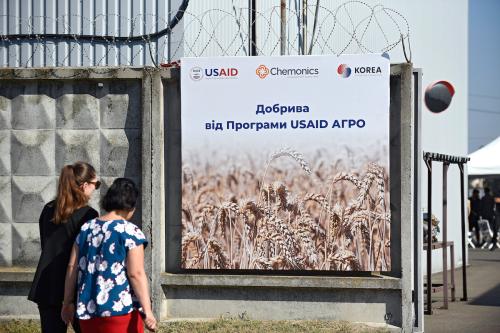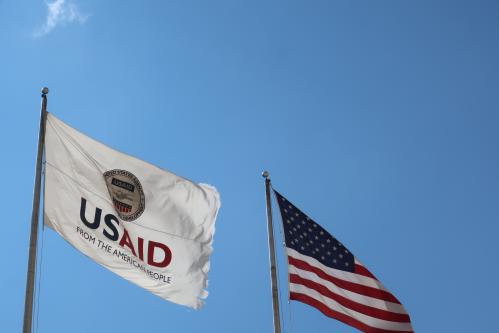On January 2, 2010, a 5.3 magnitude earthquake hit a number of remote villages in Tajikistan. According to the Associated Press, some 20,000 people were left homeless, but fortunately there were no reported deaths. The international media barely took notice of the event although Tajikistan, along with its Central Asian neighbors, lies in one of the most earthquake-prone regions of the world.
Ten days later, on January 12, 2010, a 7.0 magnitude earthquake struck Haiti. Over 220,000 people were reported killed and more than a million people left homeless. On February 27, 2010, an even stronger earthquake with the magnitude of 8.8 hit the coastal region of central Chile. It left some 450 people dead and affected more than 2 million people. The death toll of the Chilean earthquake was substantially lower than that in Haiti despite its greater strength, mostly due to better building construction, better preparedness and better response, all linked to greater wealth and better governance conditions in Chile compared to Haiti. Nonetheless, the initial response of the authorities was criticized widely for lack of adequate speed and effectiveness (see Natural Disasters, National Diligence: The Chilean Earthquake in Perspective by Daniel Kaufmann and José Tessada).
The Haiti and Chile earthquakes should serve as a wakeup call for Central Asia and for its neighbors and international friends. Located at the intersection of the Indian and Eurasian tectonic plates, all Central Asian countries[1] have significant zones of very high seismic risk – virtually all of Kyrgyz Republic, Tajikistan and Uzbekistan included – and all the big cities of Central Asia, with the exception of Astana, Kazakhstan’s new capital, lie in high-risk areas. Indeed the cities in Central Asia have a dreadful history of seismic disasters: Tashkent, Uzbekistan’s capital, was leveled by an 7.5 magnitude earthquake in 1966 with over 300,000 reported homeless. Ashgabat, Turkmenistan’s capital, was substantially destroyed in 1948 by a 7.3 quake with between 110,000 to 176,000 deaths reported. Almaty, Kazakhstan’s largest city, was severely damaged by earthquakes repeatedly between 1887 and 1911. Dushanbe, the capital of Tajikistan, experienced a 7.4 earthquake in 1907.
A recent World Bank-United Nations report systematically reviews the extraordinarily high disaster risks which Central Asian countries face and concludes that earthquakes represent the highest risk in terms of potential loss of lives and economic damage.[2] Tajikistan might lose as much as 20% of its GDP from a major seismic event. If earthquakes of past severity were to recur, damage today is estimated to be higher due to greater populations numbers and density and low building standards. If the quake that hit Dushanbe in 1907 were to recur today, some 55,000 deaths and over $1 billion in economic damage could result, according to another World Bank-United Nations report.[3] According to a 1996 estimate there is a 40% chance that a 9.0 magnitude quake will hit one of the Central Asian cities within 20 years.[4]
But not only the large cities are at risk: The densely populated Fergana Valley, home to some 11 million people and split up by jig-saw-like borders among Kyrgyz Republic, Tajikistan and Uzbekistan, faces very high risks of severe earthquakes. And the huge Sarez lake high in the Pamir mountains of eastern Tajikistan – the itself was formed by a big earthquake and a resulting landslide in 1911 – is at risk of flooding the downstream valley of the Amu Darya River with its 16 cubic kilometers of water, if another earthquake were to lead to a rupture of the naturally formed dam. Five million people are estimated to be at risk from such a flood in Tajikistan, as well as Afghanistan and Uzbekistan.
The Central Asian countries are poorly prepared to deal with this high disaster risk. As a holdover from Soviet days, each country has a government department to deal with disasters, but they have only very limited administrative and financial resources and few modern planning and response tools to prepare for and respond to a major earthquake. There is no effective regional preparedness and response capacity, an essential requirement in a region where international borders divide major population centers, such as the Fergana Valley, where the large cities are close to borders, and hence where major quakes are likely to affect more than one country at a time.[5] The quality of buildings in the region is generally poor for earthquake resistance and the population is ill-prepared for earthquakes. For example, a recent study by the Japanese International Cooperation Agency (JICA) on disaster risks in Almaty – a city for which experts consider the likelihood of a major quake occurring in the next 10-15 years as very high – concluded that most buildings have a low resistance to withstand earthquakes and that a great majority of the population have a low awareness and preparedness for the high earthquake risk.[6] According to World Bank-United Nations estimates, only 1 per cent of Central Asia’s population is covered by disaster insurance, and the insurance that is available, while low in cost, is also of low quality and lacks credible reinsurance. Moreover, with the exception of Kazakhstan, the Central Asian countries’ fiscal resources available for responding to a major natural disaster are wholly inadequate.
The international community has not been oblivious to the seismic risks that Central Asia faces. In 1996, a consortium of national and international agencies met in Almaty to review the earthquake risks for Central Asia and concluded with a call for action on a region-wide basis with international support.[7] The Asian Disaster Reduction Center organized a conference in 2003 in Kobe, Japan, with United Nations assistance to assess and plan for disaster risks in Central Asia and the Caucasus. The UNDP’s Central Asia Human Development Report of 2005 prominently addressed Central Asia’s vulnerability to natural disasters and called for a national, regional and international response. The World Bank, together with the United Nations and the Central Asia Regional Economic Cooperation Program (CAREC) mounted in 2008 the Central Asia and Caucasus Disaster Risk Management Initiative, which aims to assess the disaster risks in the region and to help develop effective preparedness and response capacity. In addition, international and bilateral aid agencies have provided support to individual countries to assist with disaster preparedness, including the UNDP for Kazakhstan and Tajikistan, JICA for Kazakhstan, the Swiss Agency for Development Cooperation for Tajikistan, while Germany’s InWEnt and USAID supported regional earthquake preparedness initiatives over the last decade. UNDP is planning an urban risk management network for the major cities of Central Asia and the Caucasus and regional disaster preparedness has been identified as an area of engagement by CAREC. A multi-stakeholder group of donors, including the World Bank and the Aga Khan Development Network successfully carried out a project to install and early warning system for downstream communities in case of a dam breakage at Lake Sarez.
Well-meaning and important as these international initiatives are, they are at best partial, uncoordinated and lacking in urgency on a regional basis. In many cases, initiatives end with calls for action with no effective follow-up, such as the 1996 consortium, the 2003 Kobe meeting, and the 2005 Central Asia Human Development Report; small-scale interventions fail to be sustained or scaled up, as with initiatives to increase awareness and preparedness at a national and local basis; earthquake risks are given lower priorities than others, as in the case of the World Bank-United Nations disaster preparedness program; and initial attention flags as in the case of CAREC’s focus on natural disaster – while the World Bank presented a progress report of the initiative at the CAREC Senior Officials Meeting in June 2009, the matter was not on the agenda of the Ministers’ Conference in October 2009 and was not even mentioned in the Joint Ministerial Statement.[8]
The bottom line is that there has been little progress in this critical area since the collapse of the Soviet Union 20 years ago, and the risk of a major disaster possibly on the scale of Haiti, is a real threat. If anything, the ability of Central Asian countries to respond to a major disaster today, similar to the Armenia earthquake in 1988, which killed 25,000 people and caused losses estimated $14.2 billion, is less than in Soviet days. National capacities are very limited, borders are hard, cooperation among countries weak, and engagement from outside the region highly constrained.
What can be done? Seven steps should be the immediate focus of action, following the dramatic warning signals that the Haiti and Chile earthquakes have sent to other parts of the world subject to high seismic risk, and especially to Central Asia.
The first step that needs to be taken is to raise the awareness and engagement on this fundamental risk at the highest political level in each country. The reality is that, even as the poorer population groups are likely to be hardest hit in case of a major quake, virtually everybody, including the countries’ presidents and elite, is at risk. The now-deceased first president of Turkmenistan, Saparmurat Niyazov, was left an orphan at a young age when his mother was killed along with most of his family in the 1948 earthquake that leveled Ashgabat.
Second, the issue of natural disaster preparedness should be put at the top of the agenda of the two key regional organizations for Central Asia: the Shanghai Cooperation Organization (SCO) and the Eurasian Economic Community (EurasEC). These organizations meet annually at the heads of state level. SCO involves not only Russia, but also China. While the capacity for financing and implementation of these two organizations is limited, their summit agreements should provide political momentum and instruct the regional implementation bodies, in particular CAREC, to develop regional strategies and action plans with international partners, including the Eurasian Development Bank, World Bank, United Nations and key bilateral agencies from Germany, Switzerland and the United States.
Third, the focus should squarely be put on earthquake preparedness and response. It represents the single largest catastrophic risk and needs priority and urgent attention.
Fourth, the focus must be regional in addition to national. Given the distribution of seismic risks in the region, the nature of the region’s population concentration and the alignment of borders, major earthquakes are likely to affect more than one country at a time. With the limited resources of each country and the need for access across borders under international response actions, only a regionally planned and executed approach is likely to be anywhere near effective. Regional cooperation in Central Asia has been weak since the breakup of the Soviet Union, partly because the newly independent countries have struggled about the allocation of precious regional resources, especially water and energy. However, preparing to face the common threat of a major earthquake, which could hit any of the countries in the region at any time, should offer win-win opportunities for all.
Fifth, the engagement of the international community must for once be truly comprehensive and coordinated. One of the implications of the major recent disasters around the globe is the great difficulty of mounting effectively coordinated responses by external humanitarian agencies. Lessons from other disasters need to be learned and learned quickly. (see Homi Kharas “Build Back Better” in Haiti: Lessons from the Indonesian Tsunami). CAREC, which has six international agencies as members and which has the goal to develop a broader partnership agenda, would be the obvious umbrella under which to aim for this comprehensive international response.
Sixth, each international and bilateral organization engaged in Central Asia should give much more attention to the issue of earthquake preparedness, not only in terms of deployment of analytical, advisory and financial resources within the region, but also in terms of assuring that its internal response capacity to a major earthquake is fully developed, tested and at the ready. Agencies also need to be sure that their own staff on the ground is housed in facilities that are likely to withstand major shocks. The tragic losses of UN personnel during the Haiti earthquake are a painful reminder of this immediate risk to the agencies themselves.
Seventh, the response should include not only a focus on better preparedness by the governments and official international agencies, but must also involve civil society at the local, national and international level. What is more, the development of private insurance mechanisms, as supported by the World Bank in Turkey, needs to be fostered proactively as recommended by a recent World Bank-United Nations report.[9]
Any serious earthquake that hits a heavily populated area will have severe consequences. The recent experience of Haiti and Chile are a tragic reminder how important effective preparedness and response are, if loss of life and damage is to be kept to a minimum. With the high risk of intensive seismic action in Central Asia, national and international attention and action must be focused on developing better risk reduction, preparedness and response in the region. It would be real progress if action is taken before the next disaster hits, rather than, as is all too often the case, after the tragedy strikes.
[1] Central Asia is defined here to include Kazakhstan, Kyrgyz Republic, Tajikistan, Turkmenistan and Uzbekistan. The population of Central Asia is about 60 million. It should be noted that the Central Asian zone of high seismic risk is part of a larger zone, which also includes Western China, Northern Pakistan, Afghanistan, Iran, the South Caucasus and parts of Turkey.
[2] “More than 91 percent of loss potential in [Central Asia and the Caucasus] is from earthquakes alone.” See The World Bank, the United Nations International Strategy for Disaster Reduction (UNISDR) and CAREC, “Central Asia and Caucasus Disaster Risk Management Initiative (CAC DRMI)”, 2009. http://www.unisdr.org/preventionweb/files/11641_CentralAsiaCaucasusDRManagementInit.pdf
[3] The World Bank, the United Nations International Strategy for Disaster Reduction (UNISDR) and CAREC, “Mitigating the Adverse Financial Effects of Natural Hazards on the Economies of Central Asia”, 2009. http://www.unisdr.org/preventionweb/files/11742_MitigatingtheAdverseFinancialEffect.pdf
[4] Ibid.
[5] United Nations Development Program, Central Asia Human Development Report, New York, 2005. http://hdr.undp.org/en/reports/regionalreports/europethecis/central_asia_2005_en.pdf
[6] JICA, “The Study of Earthquake Disaster Risk Management for Almaty City in the Republic of Kazakhstan, Interim Report, September 2008.
[7] Geohazards. “Lessons for Central Asia from Armenia and Sakhalin”, 1996. www.geohaz.org/news/images/publications/Lessons_from_ca.pdf
[8] For documentation of the Ministerial Conference see the CAREC Institute Web site under http://www.carecinstitute.org/index.php?page=eighth-ministerial-conference-on-central-asia-regional-economic-cooperation
[9] The World Bank, the United Nations International Strategy for Disaster Reduction (UNISDR) and CAREC, “Mitigating the Adverse Financial Effects of Natural Hazards on the Economies of Central Asia”, 2009.



Commentary
Op-edProtection Against Severe Earthquake Risks in Central Asia
March 23, 2010